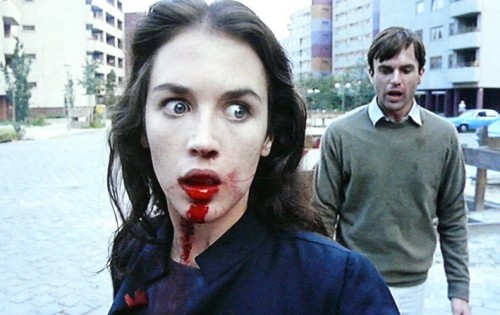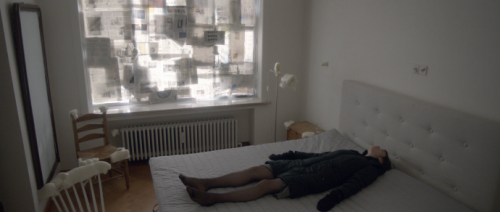
This guest post by Giselle Defares appears as part of our theme week on Demon and Spirit Possession.
Possession in horror is often linked to the control of a person by a demon or spirit. It’s an impending revelation of an evil outside one’s self. Why are we so enthralled with this concept in horror? If you follow the “Beast Within” approach, Joseph Grixti argues that horror stories evoke a certain catharsis as an important mechanism to give a place to deep psychoanalytic and suppressed desires. He believes that “human beings are worried at the core.” In other words: the catharsis within the horror genre can in this way serve as a safety measure. Is that not precisely what Aristotle said on tragedy: “Catharsis through tragedy accounts for the transformation of what would be painful in real life to what is deeply enjoyable when embodied in the structure of a work of art. ” Possession (1981) is often shelved with the other classic horror movies of the 1970s and ‘80s–think of The Exorcist (1973) or The Amityville Horror (1979)–but the horror genre doesn’t fully reflect the intricacies of the movie. Possession is a cult-drama-psychological-thriller- horror to the max.
The Polish director Andrzej Żuławski left his homeland after his second movie, The Devil (1972), was banned. He moved to France and his project Possession got financial backing from a French production studio and was shot in West Germany. His success in France gave Żuławski the opportunity to move back to Poland and work on a project of his own choice. Unfortunately, the Ministry of Cultural Affairs halted the production of his movie On The Silver Globe (1988).
Possession is inspired by real life events (well, sort of). Żuławski penned the script after his marriage to Malgorzata Braunek (Polish star of his first movies) crumbled down and he was left with the care of their son Xawery– who is now a celebrated director in his own right. After its release, the film was heavily cut in the US and banned in Britain, until an uncut VHS release in 1999. Isabelle Adjani received accolades for her role and she won the Best Actress award at the Cannes Film Festival, and vowed that she would never play a similar role again.

Possession takes place in gloomy, washed out Berlin. Mark (Sam Neill) comes back from a duty journey–as an international spy does–to his wife and young son, and finds that in his home nothing is as it seems. The opening scene of Possession is focused on the end of a marriage. Anna (Adjani) tells Mark that she feels that she has to leave him. Although she doesn’t quite understand why, she laments “Maybe all couples go through this..?” The tone is set in the first three minutes, and the unraveling of the marriage begins. Anna shows disruptive behavior, becomes unhinged, and sneaks off to her unseen lover. While Mark was away, she had a relationship with Heinrich (Heinz Bennent), who is a kung fu practicing psychiatrist and apparently sexually superior to Mark. Slowly the “family” drama is unfolding.
Possession gives us a marriage where the protagonists are conjuring the demons that we have within ourselves. It was interesting to see Mark decompose himself when Anna asks for a divorce. You slowly see him breaking down, rocking back and forth on his bed, the fear and despair seeping out of his pores. He can’t hold on to his idyllic image he created of Anna. He has to let go, but he can’t. The first half of the film focuses on the dissipation between Mark and Anna. We are voyeurs in their claustrophobic apartment. The second half has a sudden psychedelic and macabre feel. The events are more in the open and all the craziness bursts out. Mark hires a private detective to check on Anna’s whereabouts. She’s been living in an abandoned apartment where she–literally–can hide her monster. Slowly we see the monster evolving and his appearance becomes more human while Mark and Anna fall into despair, violence, and hysteria. The apocalypse is coming.
The movie is filled with metaphors. In one of their numerous shouting matches, Żuławski directly puts a car crash into the shot. Every action in Possession has a double meaning. Whether it’s the location (divided Berlin), or Anna’s hysteria, which is countered by Mark, who remains stiff and stoic. There’s a lot of excess in the movie, whether it be bodily fluids such as vomit, blood, milk, mucus, or the over spilling of emotions from Mark and Anna. While emotions run high, we’re introduced to the presence of the couple’s doppelgängers. Mark’s doppelgänger reflects Anna’s fascination with Heinrich’s persona: narcissism, religion, imagination, and his sexual freedom. Anna’s doppelgänger, Helen, is a pure, calm, and collected woman. That’s precisely what Mark wants–the opposite of Anna. Helen exclaims she comes “from a place where evil seems easier to pinpoint because you can see it in the flesh.” Alright.

The relationships are complex. Anna is depicted as the hysterical one in the relationship. Their son Bob functions as their bridge. Bob is the sole reason Anna keeps being lured back into Mark’s arms. Bob spends a lot of time underwater, while practicing his “world record in tub diving.” Anna is driven by a primal instinct, which is repressed by Marks’s cold conservatism. Mark proclaims “God is evil” and succumbs to adultery and abuse. Throughout the film there’s a shot of him gripping his wife and son’s torso, a way to out his dominance and control their body. After the infamous subway passage scene, Anna is finally able to let go of her inner evil and embraces it.
Żuławski’s directorial style is electric yet graceful. The DOP, Bruno Nuytten, uses imaginative camerawork. In various points, he shifts from handheld and shaky camerawork to fluid, kinetic shots while following the couple around. The music by Andrzej Korzunski gives the movie an extra layer of uneasiness while we see the interwoven lives of Mark and Anna unravel and we’re speeding alongside them crashing to a forceful split. Neill and Adjani’s performances are mesmerizing, and they completely submerge themselves in the unfolding hysteria. The FX master Carlo Rambaldi’s humanoid-tentacled-sex-quid monster is mainly shown in dark, shadowy shots which amps the level of gore (Rambaldi is also responsible for giving us the cuddliest of aliens E.T. The Extra- Terrestrial).
It almost seems redundant to mention it, but the comparison is easily made. Possession was the inspiration for Lars von Trier to make Antichrist (2009). Both directors use the horror genre to capture marital strife; the scenes are sexually explicit, and show self-mutilation and gruesome gore.
Żuławski kept the atmosphere dense with subcutaneous tension throughout the film. Possession is a two-hour rollercoaster of emotions and wailing, screaming, violence, sex, and bodily fluids. It shows the complexity of human relationships. Żuławski doesn’t give you the answers. The film is open to interpretation. The demons are not an outside force, but sleep in the hidden depths of our being. At least it will give you some food for thought on your intimate relationships.
[youtube_sc url=”https://www.youtube.com/watch?v=WWbJbOu9Nxc”]
Giselle Defares enjoys Googling random things, late night conversations, and can’t stray far from the impulse to write it all down. She writes on fashion, film and pop culture here.




